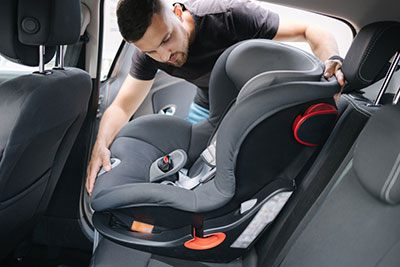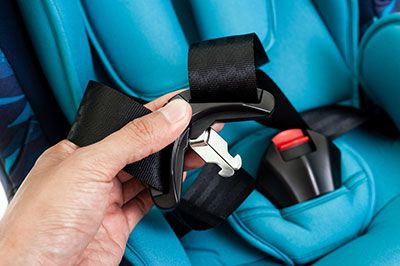Are you a mom or parent looking for reliable, up-to-date information on car seat safety? Look no further! As parents, one of the most important things we can do is to ensure that our children are safe and secure when in vehicles.
We want to know that their car safety seat is installed correctly, checked regularly for any signs of wear and tear, and used as intended.
In this blog post, we will discuss some of the best practices regarding car seat safety recommendations and guidelines so that you can feel confident knowing your children are riding safely with you.
More...
Take Away Key Points:
Table of Contents
AAP Car Seat Guidelines
While car safety seats benefit children's safety while riding in a car, it is essential to note that not all child passenger safety car seats are the same.
According to guidelines set by the American Academy of Pediatrics (AAP), these car seat stages should be used in the following order:
1. Rear-facing car seat

According to the American Academy of Pediatrics (AAP), keeping your child in a rear-facing seat for as long as possible is the safest way to travel in a vehicle.
The American Pediatric Association car seat recommends that children remain in a rear-facing seat until at least age 2, and ideally even longer until their rear-facing weight limits and height limit the rear-facing seat's capacity.
Keeping your child rear-facing car seat and in the rear-facing position provides the most comprehensive protection because it helps spread crash forces over your entire body and keeps your head, neck, and spine better aligned.
Additionally, car seat recommendations AAP guidelines stress that proper installation is essential for the safety of the child passenger.
It's important to make sure child passenger safety car seats are correctly secured with no more than 1 inch of movement when attempting to wiggle it side-to-side or front-to-back in the back seat installation.
Make sure you properly install rear-facing seats according to the vehicle owner's manual as well as check the seat's history if you bought it second-hand.
In conclusion, following the car seat guidelines set by the AAP can go a long way in helping keep young passengers safe while they're on the roads.
2. Forward-facing car seat
Moving up to a forward-facing car seat when the time is right is an important part of your child's safety while in the car.
The latest guidelines issued by the American Academy of Pediatrics (AAP) make it clear that rear-facing car seat should be used until the child reaches either age 2 or outgrows the vehicle manufacturers' weight and height limits.
Once your child has met these criteria, carefully consider when you are ready to switch to a forward-facing car seat/convertible seat with a five-point harness. The AAP recommends using this type of seat until your child reaches either 4 years old or the car seat's upper weight and height limits according to their maker's instructions.
Following these guidelines will help keep your child secure and safe during travel in its forward-facing car seat.
3. Booster seat
Making sure your child is correctly secured in the correct car seat is essential for their safety.
An excellent alternative to ensure a secure and safe journey is the American Academy of Pediatrics (AAP) car seat guidelines on booster seat mode. This type of booster seat safely and comfortably positions your child so that they can use a lap and shoulder belt system, thereby improving protection in the event of an accident.
The AAP reviewers recommend checking several criteria when assessing if each forward-facing seat/ booster seat is well suited for your child, including checking the fit of the vehicle's tail belt, how adjustable it is, and how easily it can be installed and used.
The AAP recommends that until children are four feet nine inches tall and between eight and twelve years of age, they should be kept in a harness-style car seat with a five-point harness.
After that age and height, children should transition to using a belt-positioning booster seat, ensuring their shoulder seat belt fits correctly and keeping them safe while moving. It's necessary to ensure that the seat belt fits properly on the car safety seat, or in this case, the booster seat!
Knowing the real risks involved when carrying young passengers can go a long way toward keeping them safe while driving or riding in vehicles without a booster seat.
Investing in quality products that comply with these guidelines is essential, so your child can journey safely in their back seat booster seat.
4. Seat belt use
The American Academy of Pediatrics (AAP) recommends a few key guidelines for ensuring safety with shoulder seat belts and that the vehicle seat belt fits properly along with child safety seats. To start, all children under the age of 12 should ride in the backseat unless they absolutely must ride in the front seat due to size or other factors.
The guidance recommends that children of all ages have access to an appropriate car seat and wear a lap and shoulder seat belt when riding in a vehicle. However, it is important to remember that every child is different, so parents should make sure the car seat they select fits their child properly and securely.
Additionally, it is important to adjust the car seat straps and ensure the lap belt is low on the upper thighs and not on the stomach to avoid a severe injury.
Best Car Seat Practices to Follow

Sure, here are some of the best car seat practices to keep in mind:
- Choose the right car seat for your child's age, highest weight limit, and height. When determining if a child is too tall for the seat, it's not when the child's feet touch the back of the vehicle seat. Instead, you should measure that your child's head is no more than one inch below the highest point of the car seat to determine whether they have outgrown it in height limit.
- Install the car seat correctly - make sure it's securely fastened with little to no movement when you tug on it.
- Use the appropriate harness slots and buckle positions for your child's size and car safety seat use.
- Tighten the harness straps to fit snugly over your child's shoulders and hips.
- Avoid bulky clothing or blankets that can interfere with the harness fit.
- Keep your child in the rear-facing car seat as long as possible (until at least age 2), and then a forward-facing car seat with a harness until they outgrow the seat's limits.
- Use a booster seat once your child outgrows their forward-facing car seats until they're tall enough to use a regular seat belt (typically around age 8-12). Make sure the seat belt fits properly on the child.
- Always make sure everyone in the vehicle is buckled up properly before driving.
- Regularly check your car seat for any signs of wear or damage, and replace it if necessary.
- Follow all manufacturer instructions for the car seat and vehicle installation, and consult with a certified Child Passenger Safety Technician if needed.
CDC Car Seat Guidelines: Know Your State Laws
Knowing your state laws regarding child car seats is crucial because it can help ensure you follow the legal requirements for keeping your child safe while traveling in a vehicle. Each state has specific laws and regulations around child car seat use, and these laws can vary based on factors such as the child's age, weight, and height.
By understanding your state's laws, you can make sure that you are using the appropriate type of car seat or booster seat for your child's age and size and that it is installed correctly in your vehicle. Failure to follow these laws can result in fines or penalties, but more importantly, it could put your child at risk for injury or even death in the event of an accident.
Additionally, knowing your state's laws around car seats can also help you stay informed about any updates or changes to the regulations over time. These changes may be made based on new research or safety recommendations, so staying up-to-date with current guidelines is critical for ensuring the continued safety of your child while traveling in a vehicle.
How to Pick the Best Car Seat: APA Car Seat Recommendations
Choosing the best car seat for your child can be a daunting task, but here are some crucial criteria to consider:
1. Age and size of your child: Car seats are designed for specific age ranges and weight limits, so choose one appropriate for your child's size.
2. Type of car seat: There are several types of car seats available, including infant seats, convertible seats, booster seats, and all-in-one seats. Consider which type will work best for your needs and budget.
3. Safety features: Check for car seats that have passed safety tests and meet federal safety standards. Consider features such as side-impact protection, a five-point harness system, energy-absorbing foam, and proper vehicle seat belt use. Also, check for car seat recalls on the seat of your choice.
4. Ease of use: Make sure the car seat you choose is easy to install and adjust appropriately. Look for features like clear instructions, easy-to-use buckles, and adjustable harnesses.
5. Comfort: Your child will be spending a lot of time in their car seat, so choosing one that is comfortable and has adequate padding is important.
6. Durability: Look for a car seat made from high-quality materials that can withstand daily wear and tear over time.
7. Price: Car seats range from under $50 to several hundred dollars. Set a budget before you start shopping to help narrow down your options.
By considering these criteria when selecting a car seat for your child, you can ensure that you make an informed decision that prioritizes their safety and comfort while traveling in a vehicle.

Air Bags & Car Seats: Are They Safe?
Air bags and car seats can work together to provide added safety for child passengers while traveling in a vehicle. However, it is vital to use them properly to ensure maximum safety.
Airbags are designed to deploy quickly in a crash, providing added protection for the driver and passengers. However, they can be dangerous for young children if misused. Children under the age of 13 should always ride in the back seat of a vehicle, as airbags can cause serious injuries or even death if they deploy while a child is sitting in the front seat.
Car seats are designed to keep children safe while traveling in a vehicle by providing proper restraint and protection in the event of an accident. Car seats can significantly reduce the risk of injury or death in a crash when used correctly. Remember never to place an infant car seat only or a rear-facing car seat in front of the active air bag.
When using airbags and car seats together, following all manufacturer instructions and guidelines is important. Car seats should be installed securely in the vehicle's back seat, away from any active airbags. Additionally, parents should ensure that their child's car seat is appropriate for their size and weight and installed correctly.
Overall, when used properly, airbags and car seats can work together to provide added safety for children while traveling in a vehicle.
Conclusion
In conclusion, choosing the right car seat for your child and using it properly is crucial for their safety while traveling in a vehicle.
By considering factors such as age, highest weight and height limit, type of child's seat, safety features, ease of use, comfort, durability, and price, parents can make an informed decision prioritizing their child's well-being.
Additionally, when using car seats with airbags or other safety features, following all car seat safety recommendations and instructions is essential to ensure maximum protection.
